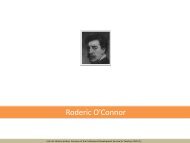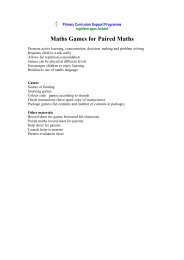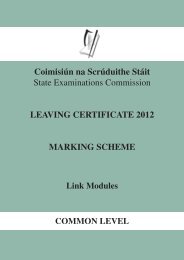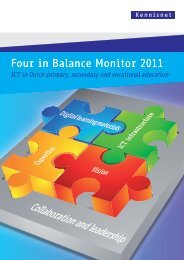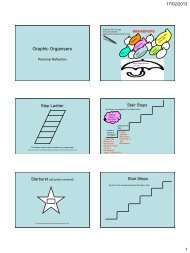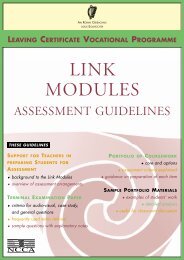GUIDELINES FOR TEACHERS - Curriculum Online
GUIDELINES FOR TEACHERS - Curriculum Online
GUIDELINES FOR TEACHERS - Curriculum Online
You also want an ePaper? Increase the reach of your titles
YUMPU automatically turns print PDFs into web optimized ePapers that Google loves.
PHYSICS<br />
Irish Times, 24 April 1994<br />
DISCOVERY OF TOP<br />
QUARK CONFIRMS<br />
KEY ATOMIC THEORY<br />
William J. Broad<br />
New York<br />
The quest begun by philosophers in ancient<br />
Greece to understand the nature of matter<br />
may have ended in Batavia, Illinois,<br />
with the discovery of evidence for the top<br />
quark, the last of 12 subatomic building<br />
blocks now believed to constitute all<br />
of the material world.<br />
An international team of 439 scientists<br />
working at the Fermi National Accelerator<br />
Laboratory announce the finding<br />
yesterday bringing nearly two decades of<br />
searching to a dramatic conclusion.<br />
The Fermilab discovery, if confirmed<br />
would be a major milestone for modern<br />
physics because it would complete the<br />
experimental roof of the grand theoretical<br />
edifice known as the Standard Model,<br />
which defines the modern understanding<br />
of the atom.<br />
The discovery, in all likelihood, will never<br />
make a difference to everyday life, but it is<br />
a high intellectual achievement because the<br />
Standard Model, which it appears to validate,<br />
is central to understanding the nature<br />
of time, matter and the universe.<br />
If the top quark could not be found, the<br />
Standard Model of theoretical physicists<br />
would collapse, touching off an intellectual<br />
crisis that would force scientists<br />
to rethink three decades of work in which<br />
governments around the globe had<br />
invested billions.<br />
All matter is made of atoms, but nearly<br />
a century ago physicists discovered<br />
that atoms, long considered to be the smallest<br />
units of matter, were themselves<br />
composed of smaller, subatomic particles<br />
like protons and neutrons. These particles<br />
later showed signs of being made of yet<br />
smaller building blocks.<br />
The field was plunged into confusion for<br />
many years until a grand unifying theory<br />
pioneered by Dr Murray Gell-Mann, a<br />
physicist at the California Institute of<br />
Technology, sought to explain the structure<br />
of particles like protons and neutrons in<br />
terms of new units that he named quarks.<br />
His theory called for the existence of six<br />
different kinds of quarks, named up and<br />
down, charm and strange, top and bottom.<br />
The quark family parallels a six-member<br />
family of lighter particles, known as<br />
leptons, that includes the electron.<br />
Various combinations of these 12 particles<br />
are thought to make up everything in the<br />
material world.<br />
Five of the six quarks: were eventually<br />
found but the sixth remained painfully<br />
absent. For nearly two decades rival teams<br />
of scientists around the world have sought<br />
the top quark by performing ever-morecostly<br />
experiments on increasingly large<br />
machines that accelerate tiny particles<br />
almost to the speed of light and then smash<br />
them together in a burst of energy.<br />
The resulting fireball can yield clues to<br />
nature’s most elementary building blocks.<br />
The experiment was run on Fermilab’s<br />
Tevatron, a four-mile, circular accelerator<br />
in an underground tunnel that hurls<br />
counter rotating beams of protons and<br />
antiprotons at each other with a combined<br />
energy of 1.8 trillion electron-volts.<br />
It is currently the highest-energy accelerator<br />
in the world.<br />
Dr Melvyn J. Shochet, the team spokesman,<br />
said the mass of the top quark, its most<br />
important attribute, was calculated to be 174<br />
billion electron-volts, plus or minus 17 billion<br />
electron-volts. “That’s quite heavy,” he<br />
said. “It’s almost as heavy as an entire gold<br />
atom. It’s by far heavier than any other elementary<br />
particle that’s been observed,<br />
which is why it’s taken so long to find.”<br />
Dr Gell-Mann took the word quark from a<br />
line in “Finnegans Wake” by James Joyce:<br />
“Three quarks for Muster Mark”. So too,<br />
Dr Gell-Mann predicted that quarks in<br />
normal matter came in groups of three.<br />
Protons would be made of two up quarks<br />
and one down quark; neutrons of two down<br />
quarks and one up quark. Dr Gell-Mann’s<br />
ideas were radical and strongly resisted,<br />
partly because the fractional charges of his<br />
quarks seemed implausible. But his theories<br />
explained much, and were soon partly<br />
confirmed by particle discoveries. In 1969<br />
he won the Nobel Prize in Physics.<br />
Low-mass quarks, the up and down, are the<br />
only ones thought to ordinarily exist in this<br />
world. Physicists believe that the higher<br />
mass ones, charm and strange, top and<br />
bottom, were present naturally only for a<br />
tiny fraction of a second at the beginning<br />
of time during the Big Bang – the primordial<br />
explosion thought to have given rise to<br />
the universe.<br />
Top quarks, having the highest mass of all,<br />
are believed to have vanished from the<br />
universe after existing for less than a<br />
billionth of a second.<br />
Thus, a time machine is needed to see most<br />
quarks. Particle accelerators slam together<br />
tiny bits of matter to create intense<br />
fireballs almost as hot as those that existed<br />
at the beginning of time, creating streams<br />
of nature’s most rudimentary particles.<br />
- (New York Times Service)<br />
31



